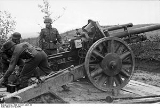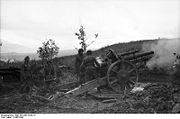
10.5 cm leFH 18
Encyclopedia
The 10.5 cm leFH 18 ( "light field howitzer") was a German light howitzer
used in World War II
.
 The 10.5 cm leFH 18 was the standard divisional
The 10.5 cm leFH 18 was the standard divisional
field howitzer used by the Wehrmacht during the Second World War. It was designed and developed by Rheinmetall
in 1929-30 and entered service with the Wehrmacht
in 1935. Generally it did not equip independent artillery battalions until after the Battle of Stalingrad
in 1943. Before 1938 the leFH 18 was exported to Hungary and Spain. 53 were also exported to Finland, where they were known as 105 H 33. 166 leFH were exported to Bulgaria in 1943 and 1944 (until February 1st, 1944)
. In 1941 a muzzle brake was fitted to allow longer range charges to be fired. This increased the range by about 1,800 yards and was known as the leFH 18M. In March 1942 a requirement was issued for a lighter howitzer. This led to a second modification, known as the leFH 18/40. This modification consisted of mounting the barrel of an leFH 18M on the carriage for a 7.5 cm PaK 40 antitank gun. The new carriage increased the rate of fire as well as making the howitzer lighter. Additionally, a more efficient muzzle brake was added, decreasing the recoil. Ballistically, the 10.5 cm leFH 18M and the leFH 18/40 are identical.
Howitzer
A howitzer is a type of artillery piece characterized by a relatively short barrel and the use of comparatively small propellant charges to propel projectiles at relatively high trajectories, with a steep angle of descent...
used in World War II
World War II
World War II, or the Second World War , was a global conflict lasting from 1939 to 1945, involving most of the world's nations—including all of the great powers—eventually forming two opposing military alliances: the Allies and the Axis...
.
History

Division (military)
A division is a large military unit or formation usually consisting of between 10,000 and 20,000 soldiers. In most armies, a division is composed of several regiments or brigades, and in turn several divisions typically make up a corps...
field howitzer used by the Wehrmacht during the Second World War. It was designed and developed by Rheinmetall
Rheinmetall
Rheinmetall AG is a German automotive and defence company with factories in Düsseldorf, Kassel and Unterlüß. The company has a long tradition of making guns and artillery pieces...
in 1929-30 and entered service with the Wehrmacht
Wehrmacht
The Wehrmacht – from , to defend and , the might/power) were the unified armed forces of Nazi Germany from 1935 to 1945. It consisted of the Heer , the Kriegsmarine and the Luftwaffe .-Origin and use of the term:...
in 1935. Generally it did not equip independent artillery battalions until after the Battle of Stalingrad
Battle of Stalingrad
The Battle of Stalingrad was a major battle of World War II in which Nazi Germany and its allies fought the Soviet Union for control of the city of Stalingrad in southwestern Russia. The battle took place between 23 August 1942 and 2 February 1943...
in 1943. Before 1938 the leFH 18 was exported to Hungary and Spain. 53 were also exported to Finland, where they were known as 105 H 33. 166 leFH were exported to Bulgaria in 1943 and 1944 (until February 1st, 1944)
Description
It had a heavy, simple breech mechanism with a hydro-pneumatic recoil system. The 10.5 cm leFH 18 had wood-spoked or pressed steel wheels. The former were only suitable for horse traction. Initially, it was not fitted with a muzzle brakeMuzzle brake
Muzzle brakes and recoil compensators are devices that are fitted to the muzzle of a firearm or cannon to redirect propellant gases with the effect of countering both recoil of the gun and unwanted rising of the barrel during rapid fire...
. In 1941 a muzzle brake was fitted to allow longer range charges to be fired. This increased the range by about 1,800 yards and was known as the leFH 18M. In March 1942 a requirement was issued for a lighter howitzer. This led to a second modification, known as the leFH 18/40. This modification consisted of mounting the barrel of an leFH 18M on the carriage for a 7.5 cm PaK 40 antitank gun. The new carriage increased the rate of fire as well as making the howitzer lighter. Additionally, a more efficient muzzle brake was added, decreasing the recoil. Ballistically, the 10.5 cm leFH 18M and the leFH 18/40 are identical.
External links
- http://www.wlhoward.com/id1074.htm Ordnance Technical Intelligence Museum Webpage
- http://www.germanwarmachine.com/weapons/artillery/lefh18.htm
See also
- Weapons employed in the Slovak–Hungarian War

